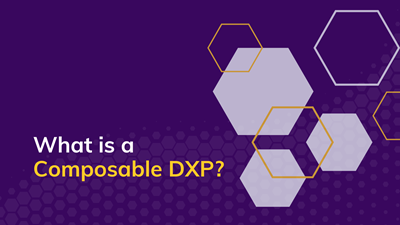What Is a Composable DXP


Building, Not Buying: The Essence of Composable DXPs
A composable DXP is not a ready-made product you can buy and use immediately. Instead, it's a strategic framework made up of different technologies that work together to meet specific business needs. This setup helps you select the right tools and services for managing content and analyzing customers, all working together effectively.
The journey toward adopting a composable Digital Experience Platform (DXP) is fundamentally different from purchasing a conventional, off-the-shelf software solution. It's a deliberate, strategic process of assembling a tailored digital ecosystem from a variety of best-of-breed technologies. This approach allows businesses to handpick the most suitable tools for content management, customer data analysis, digital marketing, and more, ensuring each component integrates seamlessly to create a cohesive platform.
By embracing a composable DXP, organizations are not just investing in technology; they are investing in a future-proof infrastructure that can adapt to evolving digital trends and customer expectations. This setup empowers businesses to leverage the strengths of each selected technology, resulting in a superior, unified digital experience across all customer touchpoints. It also offers unparalleled flexibility and scalability, allowing for the easy introduction of new tools or services as business needs change, without disrupting the existing digital ecosystem.
The Misuse of "Composable" in DXP Solutions: A Critical Insight
"Composable DXP" has emerged as a trendy buzzword, with numerous vendors positioning their offerings as the epitome of flexibility and customization. However, a deeper dive into these claims often reveals a gap between the promise of composability and the reality of the solutions on offer. The issue at hand is not vendors offering an all-in-one package; rather, it's that many of these so-called "composable" DXPs provide only a limited set of tools, typically anchored around a Content Management System (CMS), and fall short of delivering the full spectrum of capabilities needed to qualify as a composable DXP.
This discrepancy raises a crucial point for businesses on the lookout for a DXP solution: the essence of a genuinely composable DXP lies in its ability to seamlessly integrate a wide array of best-of-breed technologies, not just a select few. True composability means having the freedom to choose the most fitting tools for every aspect of your digital experience, from content management and e-commerce platforms to customer data platforms (CDPs) and personalization engines. It’s about creating a bespoke ecosystem that precisely caters to your unique business needs, goals, and customer expectations.
The challenge with vendors using "composable DXP" as a differentiator while offering a limited toolkit is that it can mislead businesses into thinking they are getting a fully flexible and scalable solution, when in reality, they may be boxed into a corner with limited options for customization and future growth. This situation can lead to significant constraints on a business’s ability to adapt to new market demands or to integrate innovative technologies that could enhance the customer experience.
When assessing potential DXP partners, it's imperative for businesses to scrutinize the depth and breadth of the ecosystem that a vendor can support. Questions should be asked about the ease of integration with third-party solutions, the availability of APIs, and the vendor's commitment to supporting a truly modular and extensible platform. Understanding the vendor's roadmap and how they plan to embrace emerging technologies can provide insights into whether they are genuinely invested in offering a composable solution or merely capitalizing on a trending term.
The Modular Advantage
The beauty of a composable DXP lies in its inherent flexibility and scalability. Businesses can easily connect different SaaS products using APIs by using a cloud-native architecture and microservices.
This simplifies the exchange of data and connection of systems. It also allows for separate updates or replacements of each part. This reduces disruptions and ensures readiness for the future in the digital ecosystem.
Personalization at Scale
In today's digital-first world, personalization is not just a luxury; it's a necessity. A flexible DXP is excellent at providing personalized content by gathering and studying real-time customer data. As a result, it improves user experiences and builds stronger customer relationships. Customizing digital interactions based on individual preferences and behaviors is crucial for success in both B2C and B2B settings.
Composable vs. Monolithic DXP
The distinction between composable and monolithic DXPs is stark. Monolithic platforms, while comprehensive, often suffer from complexity and inflexibility, burdening organizations with unnecessary features and cumbersome updates. A composable DXP is flexible and efficient, helping businesses quickly adjust to market changes and new technology.
Often, at the heart of any DXP is a Headless Content Management System (CMS) used for creating and sharing content on different channels. This headless approach allows developers and marketers to work more collaboratively, streamlining workflows and enhancing overall productivity.
The Benefits of Adopting a Composable DXP
The advantages of transitioning to a composable DXP are manifold. From accelerating time-to-market and improving content flexibility to increasing customer visibility and optimizing touchpoints, the impact is profound. By establishing an intelligent architecture and creating an integrated control center, businesses can deliver consistent, compelling digital experiences that drive customer retention and loyalty.
A composable DXP allows brands to keep up with new technologies without getting stuck with technical debt. This not only ensures operational efficiency but also secures a competitive edge in the digital arena.
Personalization at Its Best
Another standout features of composable DXPs is the ability to enhance personalization. Companies can provide personalized content to individual users by using up-to-date information. They can achieve this by combining different tools such as a headless CMS, digital asset management, and customer data platforms. This not only improves engagement but also drives customer loyalty and satisfaction.
Tailored for Every Business Size
It's a common misconception that composable DXPs are only suitable for large enterprises. In reality, the modular nature of these platforms makes them an excellent choice for businesses of all sizes. Start-ups and small businesses, in particular, can benefit from the ability to start small and scale their digital experience platform as they grow, avoiding unnecessary upfront costs and complexities.
Implementing a Composable DXP: Key Considerations
When embarking on the journey to implement a composable DXP, here are some critical factors to ponder:
Assessing Business Requirements
Before diving into the world of composable DXPs, it's crucial to conduct a thorough assessment of your business requirements. Understand the specific challenges and opportunities within your digital ecosystem. This involves identifying current gaps, what you need to to enhance digital experiences, and the goals you aim to achieve.
Choosing the Right Components
The key to a successful composable DXP lies in selecting the right components. They should all align with your business goals, integrate seamlessly, and offer the flexibility to evolve.
Integration and Interoperability
A major challenge in creating a composable DXP is making sure all components work well together. This requires a strong focus on integration and interoperability. Businesses must ensure that data moves smoothly between systems and that the user experience remains consistent across all touchpoints. This can be achieved through the use of APIs and microservices.
Technical and Organizational Readiness
The shift to a composable DXP is not only a technical endeavor but also an organizational one. It requires a cultural shift towards agility and continuous improvement. Assessing both technical and organizational readiness is vital. This includes ensuring that your team has the necessary skills and mindset to embrace a modular digital experience platform.
The Bottom Line: A Strategic Imperative
A composable DXP is essential for brands to succeed in the digital age, not just a technological choice. A composable DXP is essential for survival in the digital marketplace as it enables personalized, scalable, and agile digital experiences.
Leveraging Agility CMS in a Composable DXP Framework
When exploring the components that form the backbone of a composable Digital Experience Platform, the choice of a content management system (CMS) is paramount. Agility CMS stands out as a prime example of a tool that brings to life the core principles of a composable DXP. Designed with flexibility, scalability, and user-friendliness in mind, Agility CMS embodies the essence of what makes a composable architecture so beneficial for modern digital strategies.
Unmatched Flexibility and Scalability
Agility CMS offers an unparalleled level of flexibility, allowing businesses to craft and manage their digital experiences with ease. Being a headless CMS, it separates the content presentation layer from the content management system itself. This decoupling allows developers to use any programming language and framework to build the frontend, offering the freedom to create custom digital experiences across various channels and devices without constraints.
Streamlined Content Management
At the heart of Agility CMS is a user-centric approach to content management. It provides a streamlined, intuitive interface that empowers content creators to publish content more efficiently, without requiring deep technical knowledge. This ease of use significantly reduces the time-to-market for new content and campaigns, enabling marketers to respond swiftly to market trends and customer demands.
Enhanced Personalization Capabilities
In a digital landscape where personalization is key to engaging and retaining customers, Agility CMS excels by enabling dynamic content delivery. It allows businesses to tailor content to individual user preferences and behaviors, creating a more personalized and engaging user experience. This capability is crucial for businesses aiming to build deeper relationships with their audience in a highly competitive digital environment.
Robust Ecosystem Integration
A cornerstone of a successful composable DXP is the ability to seamlessly integrate with other best-of-breed solutions. Agility CMS shines in this aspect, offering robust APIs and out-of-the-box integrations with e-commerce platforms, digital asset management systems, customer relationship management (CRM) tools, and more. This ease of integration ensures that businesses can create a cohesive technology stack that meets their unique needs, enhancing operational efficiency and providing a seamless user experience.
Future-Proofing Your Digital Strategy
Choosing Agility CMS as part of your composable DXP strategy means investing in a platform that grows with your business. Its cloud-native architecture ensures high performance, reliability, and scalability, allowing your digital experience platform to evolve as your business expands and as technology advances. With Agility CMS, businesses can future-proof their digital strategy, ensuring they remain at the forefront of digital innovation.

About the Author
Harmonie is the Senior Marketing Manager at Agility CMS
